
15 minute read
BELGRADE WILL BE A SMARTER CITY
INTERVIEW
What is foreseen by Belgrade’s Development Plan and the new General Urban Plan? How many square meters of residential and business space can we expect to be built in our capital in the next few years? Are towers to become a new building trend? These are some of the questions we asked Marko Stojčić, Belgrade’s Chief Urbanist
Advertisement
By:
GORDANA KNEŽEVIĆ MONAŠEVIĆ
Photo:
MILOŠ LUŽANIN
Marko Stojčić, Belgrade’s Chief Urbanist
M
ore greenery and recreational spaces, less traffic congestion, well structured market places and squares, more bridges, garages and parking spaces, more downtown offices and more quality apartments at affordable prices.... These and similar issues may be raised by any citizen of any metropolis, so these questions came up in our interview, too.
However, Belgrade being at its building expansion peak for some years now opens additional questions, not to mention the launching of the metro construction whose very first line, as unbelievable as it seems at this moment, will radically change the city’s bloodstream six years from now. If we add to all this the new Urban Plan to be adopted this year which will determine future directions of spatial development – then we can say that in our interview with Belgrade’s Chief Urbanist, Marko Stojčić, we have covered practically all issues related to the structure and functioning of the city.
Reports are showing record number of issued building permits in the past year, most of them for residential buildings in Belgrade. Where in Belgrade can we find space available for building and is the current pace of construction adequate considering enormous demand? — Demand is much higher than supply simply because the citizens of Belgrade and other places in Serbia, and even foreign citizens, consider the purchase of an apartment in Belgrade to be a secure investment. Actually, the need for apartments in buildings is limited, what Belgrade really needs is more private houses. I expect the number of demands for building plots for private houses to increase in the future, particularly for those in closed residential complexes. This implies settlements with 10, 20, 50, 100 or 200 houses, with total control over security and maintenance, with some public services included, such as private schools, kindergartens, etc. We are receiving requests from investors on a daily basis for projects of this kind, and we are looking into administrative regulations to provide space for this type of construction.
Where can we expect this new type of settlements to develop?
— They could be developed in Palilula, Voždovac and Surčin municipalities. Palilula is quite a large municipality, and by this I mean primarily the left bank of the Danube river. There is quite a lot of space which has not yet been urbanised and this is where the plots could be bought up for this purpose. Surčin also encompasses a large area. This is all within the limits of the General Urban Plan. Belgrade’s population is not growing, actually it is declining to some extent, and we will make an effort in the next few years to increase the number of residents by 5 % by undertaking some strategic measures. So, for the time being, residential buildings which are currently in the planning phase will meet the city’s needs. When it comes to residential buildings in Belgrade, there is a lack of affordable apartments. Having this in mind, we have allocated parts of the Makiš area, beyond the Čukarička slope towards Železnik, where such residential area is expected to be developed. These are types of buildings which are lacking, when it comes to the needs of people looking to buy property.
But these projects are probably not profitable enough to be attractive for investors?
— That is right, but I expect them to reorient themselves to building cheaper residential buildings and settlements with private houses, once that demand for the current type of buildings decreases.
Is there a great interest for investing in construction of residential buildings and does it come from local or foreign investors?
— Interest is huge. Roughly, we are talking about 10 investment requests per one available location. The percentage of local investors is growing daily in comaprison with foreign

Marina Dorćol will be a new commercial and residential complex in the surroundings of the line park
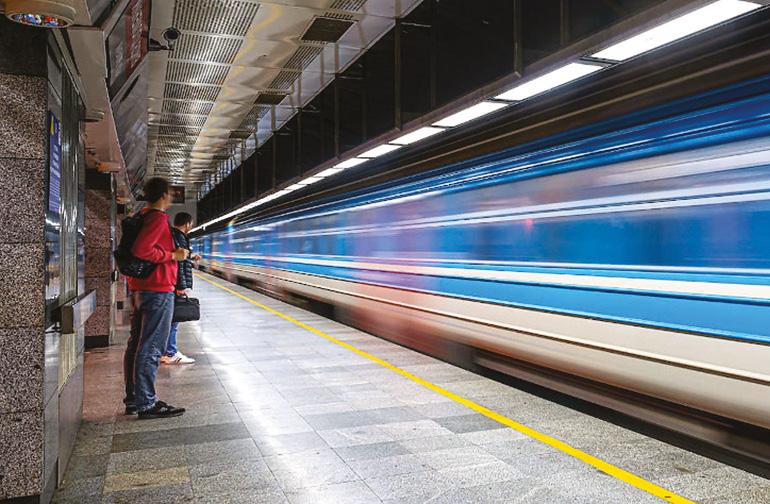
New look of the Kalenić market
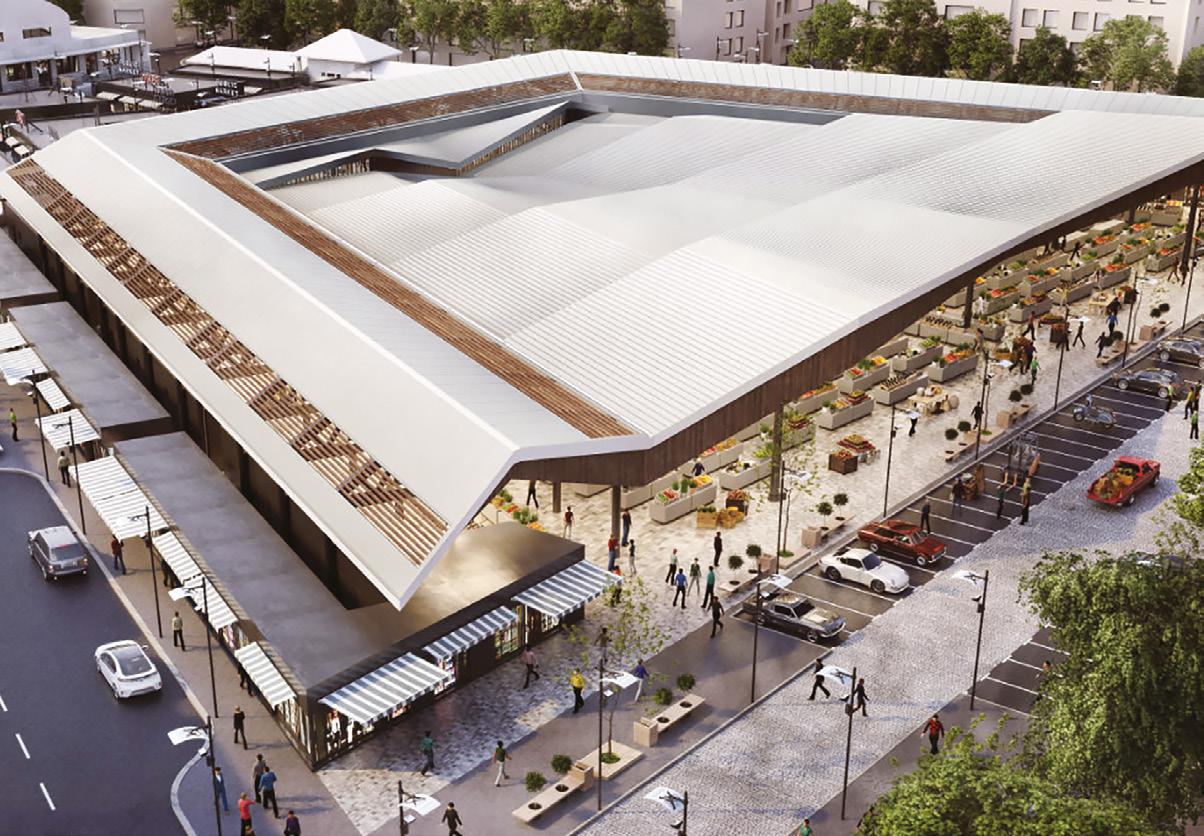
ones, showing that the local investors are waking up. At the beginning of the 2014/2015 building surge, dominant investors were foreign companies, but this has been changing recently in favour of local investors, which is good of course, because the profit stays in Serbia.
What are the plans regarding construction of new office spaces in Belgrade? This is where we have the most evident disparity between the existing supply and demand.
— In comparison with neighbouring countries, Belgrade has least amount of commercial space per capita, although it is growing into a regional hub of the Balkans. In this sense, a growing need for building more business space is expected in the following years. It is estimated that around three million square metres of business space will be built in the next ten years, including business centres, office space, business parks... The number of residential buildings is several times higher than the number of commercial buildings, but I expect these figures to come closer in the next few years.
There seems to be a problem with the fact that everyone wants to have offices in the centre of the town, which is already fully occupied?
— There is space available for building new commercial premises. In the Voždovac municipality, for example, there are one or two locations near Torlak where the construction of a business centre for bioengineering is planned. Agricultural business centre will be built in Batajnica. And there is New Belgrade, of course, always very high on the investors’ agenda. There is a trend of reconstructing old buildings in the central zones of town, such as BIGZ, Belgrade Palace... Practically all buildings belonging to what used to be socially owned companies and which are currently out of use, such as Geneks tower, for example, will be converted into new business centres, and these projects are currently under consideration.
BG metro and train will considerably reduce the number of private cars on the road
From the urbanistic point of view, while we still have small streets in the centre of the town with buildings seeming to belong to the century before last, there is also a growing number of buildings which will considerably change the appearance of the wider city centre, such as Belgrade Waterfront and Marina Dorćol. What are your views on these contrasts?
— When it comes to the buildings in the city centre which are not part of the cultural heritage, and which should be, according to the urban plan, replaced by the new ones, there are probably some unresolved ownership issues, or due to their owners’ asking price they are not attractive for investors. But all these issues will be solved in due time. As to Marina Dorćol, its location is justifiable. The line park envisaged to stretch behind it will activate the whole area. There is no justification for having industrial buildings in the centre of the city, so it is the new residential and commercial complexes that will change the appearance of the wider central zone. Of course, it is important to keep in mind architectural and quality considerations, as well as current global trends implying a different way of living and princliples of building, sale and use of public space, commercial buildings... These trends, apparent in many European cities, are applied, for example, in the Belgrade Waterfront project.
Interestingly, there seems to be an emerging tower building trend...
— It is natural that every investor aims to maximise the potential of their location. We have a study of high rise building projects which need to be constructed in order for the location to be planned for high rise building. This type of construction is prohibited in the central city zone, however, this trend is present in New Belgrade. At this moment, approximately ten buildings of 80 to 180 metres hight are under consideration. Everyone who can provide proof of construction feasibility for such a project, as well as evidence
that it will not endanger the environment, can be issued a building permit.
The line park construction has started. What is the work schedule and the deadline?
— Belgrade Greenery is in charge of the first two segments and these works are underway, to be followed by the purchase of the material for the construction of segments 3 to 10. There will be many benefits from the line park for Belgrade. Most importantly, the space which used to be bounded by the railway track and which cannot be used by pedestrians now, will be used to connect the Sava and Danube embankments with currently existing parts of town or areas under construction. The line park will cut through this area, but will have the connection function. At the same time, the proportion of greenery will be drastically increased, which will contribute to efforts to improve Belgrade’s air quality. Additionally, we will create a new recreational space which is lacking in the central city area. We will practically connect Ada Huja with Ada Ciganlija making it possible to walk from one forest to the other. According to our estimates, the line park will be completed in three years time. Construction works are finished, but there are many ownership issues to be resolved along that route.
Who are the designers and investors of the line park?
— Our initial idea was to engage a major foreign design studio, but then we decided to give a chance to our own young people. We issued a tender for architectural design and received ten different solutions for ten segments of the project. Some 55 young architects are given an opportunity to do something beautiful and important for their city. We are more than satisfied with their solutions which are now being elaborated. As to investors, they are the companies situated in the vicinity of the line park which have their interest in investing in it – Marina Dorćol, K distrikt and Belgrade Port.
What will be the major investments this year when it comes to city planning?
— Apart from the metro, which is the joint project between the Republic and the City, when it comes to planning of the public space, major investments are foreseen in relation to the line park construction, which is a three-year project. This year we are working on the project documentation and are currently waiting for the building permit, but next year the progress will be measured by kilometers. Some of the high cost investments are constructions of the tunnels and bridges, these projects are being processed. The first one to be built is the Sava bridge, followed by the bridge near Ada Huja, both of them probably next year. After the completion of the Ada Huja bridge, it is planned to have the Pančevački bridge reconstructed.
Which streets will be reconstructed this year? — The walking area around the Knez Mihajlova street will be expanded to cover a part of the Kralja Petra street all the way to Kosančićev venac. Reconstruction works of the Nikola Pašić square will probably
ACCORDING TO OUR ESTIMATES, AROUND 3 MILLION SQUARE METERS OF COMMERCIAL SPACE WILL BE CONSTRUCTED
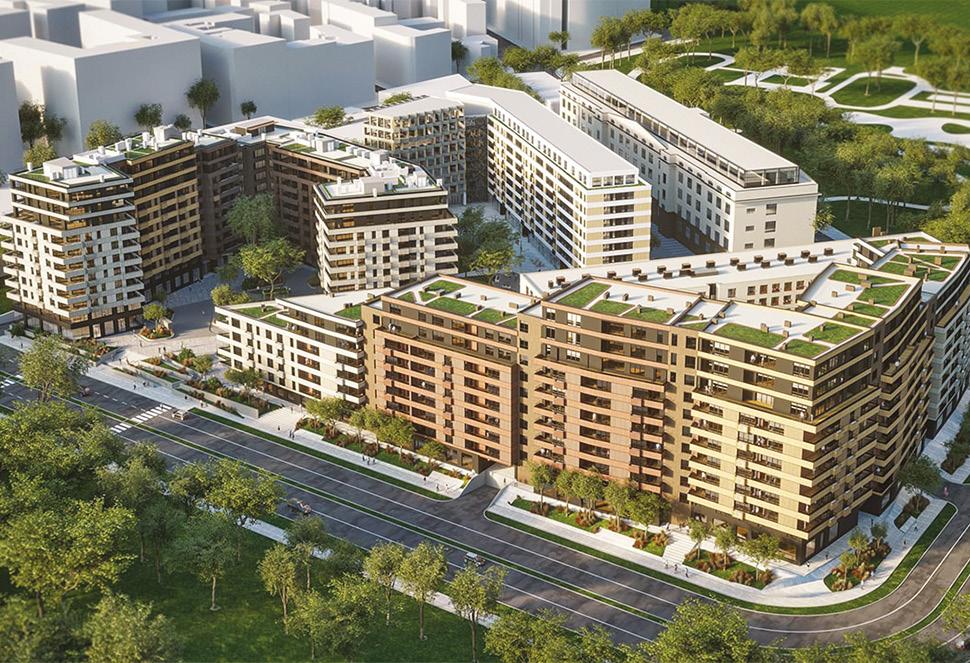
The reconstructed Belgrade Palace: the trend of reconstruction of old buildings and their conversion to new business centres will continue K distrikt: one of the projects which will change the appearance of the city’s old central zone

commence this year. Next year we will work on Bezistan. Construction of two public garages is also foreseen. The construction of the Patrijarh Pavle street in Rakovica is continuing, as the most important link between this part of town with the bridge over Ada.
Is the reconstruction of the green markets planned?
— The first in line for renovation is the Kalenić market, the permit has already been obtained. The marketplace will be covered, but not completely. The entrances from the Maksim Gorki street will be pulled in a little to allow for the widening of the street with an additional traffic lane. The renovation of the Kalenić market begins this year, and as soon as viable. Another one is the Bajloni market, this will be a complete reconstruction, according to the winning design it is to become a market-square. It is particularly interesting that the design solution foresees construction of a large public parking garage under the market place. Initially, it will also serve to accommodate the vehicles of Skadarlija visitors. The garage construction and the market renovation will be carried out simultaneously. A metro station will be located in the left market area, along the first metro line. This is planned for the next year.
You were the chairman of the jury which selected the best design of the first Belgrade metro line. What are you comments of the winning design?
— We received various solutions, but the OBE studio stood out from the very first moment. The jury members decided unanimously to select them because they fully met our criteria, which was to provide an original idea for the stations, not recycled solutions of other European cities, we wanted it to be Serbian but at the same time in line with modern architectural trends, and possibly with some historical elements included. And this is the kind of solution we were offered, a modern one. When we enter these stations one day, I am sure we will experience them to be just appropriate for Belgrade.
When is the construction of the station scheduled to begin?
— Ownership issues at all foreseen station locations
WHEN IT COMES TO GAPS IN THE REAL ESTATE MARKET IN BELGRADE, THERE IS A LACK OF AFFORDABLE APARTMENTS. THESE ARE TYPES OF BUILDINGS WHICH ARE LACKING, WHEN IT COMES TO THE NEEDS OF PEOPLE LOOKING TO BUY PROPERTY
must be resolved, project documentation completed and construction permits obtained. The construction itself will not begin this year. We have not set the final date yet, but the second half of the next year is a realistic time for launching the construction of metro stations, both underground and above ground.
Two hundred and fifty people worked on the Belgrade 2030 Development Strategy. What is foreseen by this Strategy?
— In essence, we have elaborated a development vision of Belgrade for the next seven years, up to 2030. This vision covers all sectors of society as well as the spatial development of the city. We have reached many conclusions related to Belgrade’s future development, its economic and educational segments, tour-
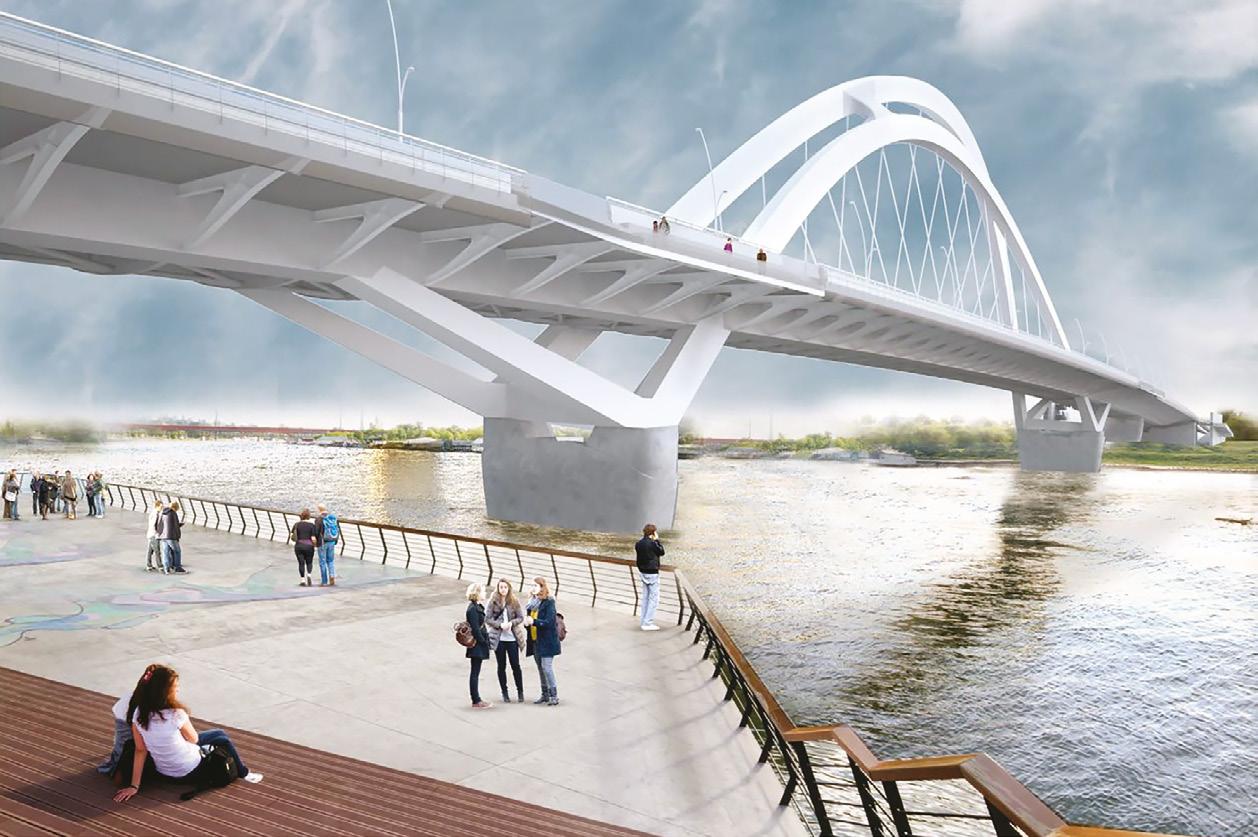
Conceptul design proposal for the bridge near Ada Huja The construction of the new Sava bridge will start next year

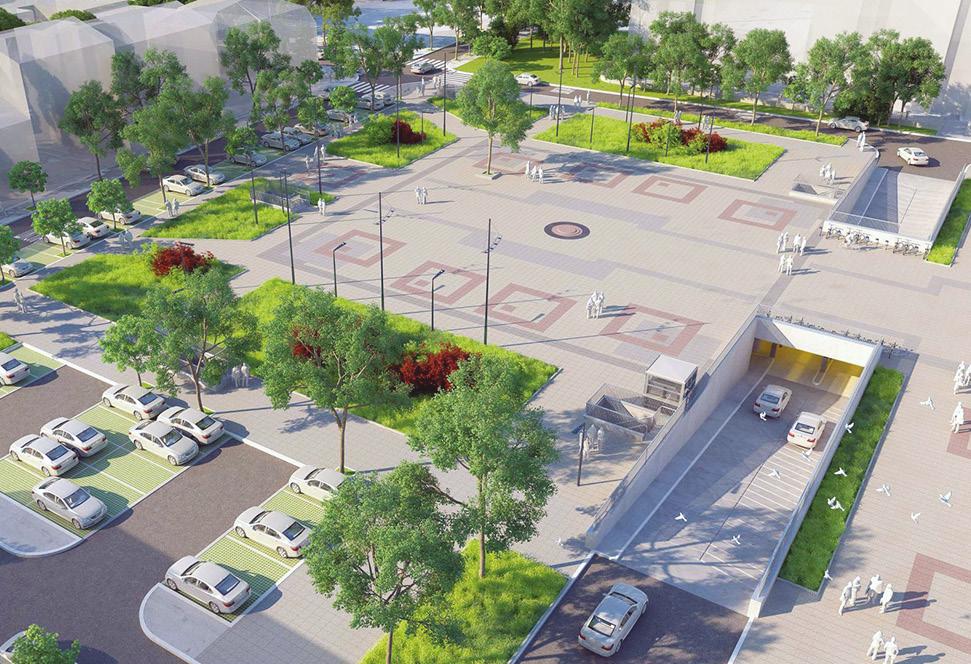
The line park will be 4.3 km long and will connect Ada Ciganlija with Ada Huja

istic potentials, recreation spaces, traffic, demographic development, ideas related to development of residential and commercial buildings and student campuses... These conclusions are just initial steps and will be integrated in the most important city document – the General Urban Plan. This plan is a binding document for all institutions and city managers, in terms of Belgrade’s future development.
How is Belgrade’s development foreseen by the new General Urban Plan?
— The General Urban Plan covers the period up to 2041, it is a projection for the 20 years period and it gives clear and comprehensive answers as to how and where will space be allocated according to different purposes. Our goal is to make Belgrade a smarter city, not in the smart-city sense, but smarter in terms of the population composition, to have more educated people, with an increase of economic activities based on intellectual assets. In this sense, we have introduced a new urban function – intellectual industry, which implies different hubs for various purposes, business centres providing intellectual services, not only for clients in Serbia, but also for Europe and globally. We expect these business complexes to prevail over other economic activities in Belgrade. Firstly, because this is profitable, and secondly, these activities consume minimal city resources. In line with this idea, we have developed the General Urban Plan based on an increased number of cultural facilities, more recreational spaces and green areas, a much better traffic network based on the BG metro and train, which should reduce the number of private cars on the road, in order to make free space for the greenery instead of traffic.
How many square meters of new residential and commercial space is anticipated by the General Urban Plan?
— We have not determined the number of square meters, it all comes down to demographics, to the number of Belgrade residents. We based our plans on the estimate that Belgrade’s population will increase by 50,000 people in the next 20 years. Belgrade’s population figures are currently stagnating. We expect to create conditions for around 25,000 who left Serbia to return to the capital in the next few years, and we also expect some 25,000 foreigners from all over the world to settle in Belgrade. It is an ongoing trend already. During the pandemic, some 1,200 US citizens moved to Belgrade, mostly in relation to intellectual economic acitivites. Pople from Russia, France and even Asia moved here, because Belgrade and Serbia are the gate of Europe. These activities will allow us to some extent to make a selection of people settling in Belgrade, in terms of attracting people who will contribute to economic and city development.
The construction of an underground public garage near the Pinki hall is planned for this year
ABOUT MARKO STOJČIĆ
Marko Stojčić is an architect by profession. He has been a member of the Architectural Chamber of Serbia since 2008, Serbia’s Association of Architects since 2001, Serbia’s Society of Architects, and holds an independent artist status in ULUPUDS (Association of fine and applied artists and designers of Serbia) since 2001. He is a responsible licensed urbanist, chief designer, and responsible contractor. He is the initiator of the establishment of Architectural Chamber of Serbia. He has been actively engaged in designing public, residential, commercial and sports facilities, as well as public spaces since 2001. Stojčić is the founder and the Chief Editor of the „Arhitekton“ magazine. In 2019 he was elected Belgrade’s Chief Urbanist.










